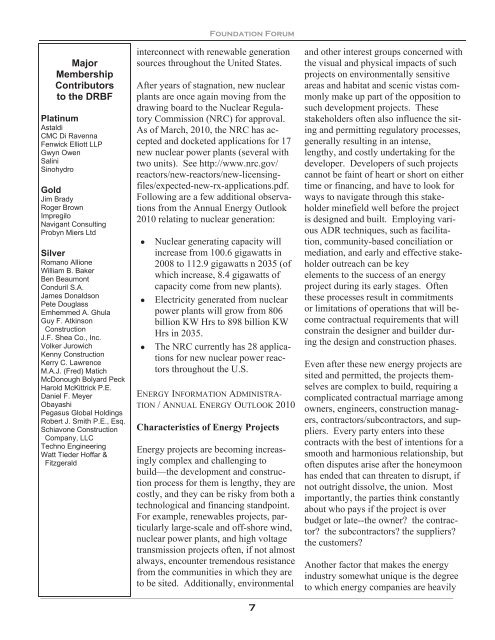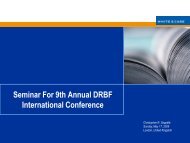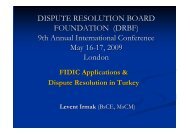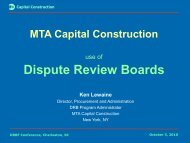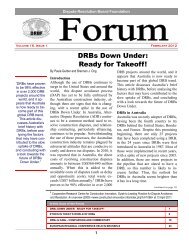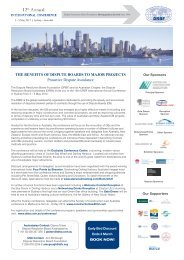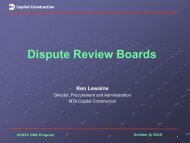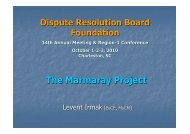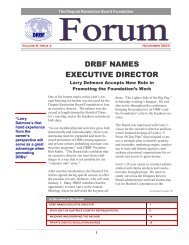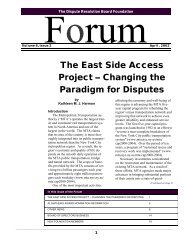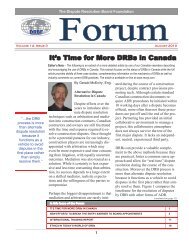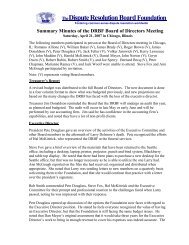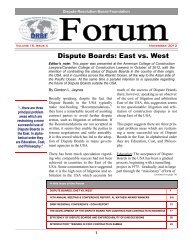Compatibility of Dispute Boards with Australia's Security of ...
Compatibility of Dispute Boards with Australia's Security of ...
Compatibility of Dispute Boards with Australia's Security of ...
Create successful ePaper yourself
Turn your PDF publications into a flip-book with our unique Google optimized e-Paper software.
Major<br />
Membership<br />
Contributors<br />
to the DRBF<br />
Platinum<br />
Astaldi<br />
CMC Di Ravenna<br />
Fenwick Elliott LLP<br />
Gwyn Owen<br />
Salini<br />
Sinohydro<br />
Gold<br />
Jim Brady<br />
Roger Brown<br />
Impregilo<br />
Navigant Consulting<br />
Probyn Miers Ltd<br />
Silver<br />
Romano Allione<br />
William B. Baker<br />
Ben Beaumont<br />
Conduril S.A.<br />
James Donaldson<br />
Pete Douglass<br />
Emhemmed A. Ghula<br />
Guy F. Atkinson<br />
Construction<br />
J.F. Shea Co., Inc.<br />
Volker Jurowich<br />
Kenny Construction<br />
Kerry C. Lawrence<br />
M.A.J. (Fred) Matich<br />
McDonough Bolyard Peck<br />
Harold McKittrick P.E.<br />
Daniel F. Meyer<br />
Obayashi<br />
Pegasus Global Holdings<br />
Robert J. Smith P.E., Esq.<br />
Schiavone Construction<br />
Company, LLC<br />
Techno Engineering<br />
Watt Tieder H<strong>of</strong>far &<br />
Fitzgerald<br />
Foundation Forum<br />
interconnect <strong>with</strong> renewable generation<br />
sources throughout the United States.<br />
After years <strong>of</strong> stagnation, new nuclear<br />
plants are once again moving from the<br />
drawing board to the Nuclear Regulatory<br />
Commission (NRC) for approval.<br />
As <strong>of</strong> March, 2010, the NRC has accepted<br />
and docketed applications for 17<br />
new nuclear power plants (several <strong>with</strong><br />
two units). See http://www.nrc.gov/<br />
reactors/new-reactors/new-licensingfiles/expected-new-rx-applications.pdf.<br />
Following are a few additional observations<br />
from the Annual Energy Outlook<br />
2010 relating to nuclear generation:<br />
●<br />
●<br />
●<br />
Nuclear generating capacity will<br />
increase from 100.6 gigawatts in<br />
2008 to 112.9 gigawatts n 2035 (<strong>of</strong><br />
which increase, 8.4 gigawatts <strong>of</strong><br />
capacity come from new plants).<br />
Electricity generated from nuclear<br />
power plants will grow from 806<br />
billion KW Hrs to 898 billion KW<br />
Hrs in 2035.<br />
The NRC currently has 28 applications<br />
for new nuclear power reactors<br />
throughout the U.S.<br />
ENERGY INFORMATION ADMINISTRA-<br />
TION / ANNUAL ENERGY OUTLOOK 2010<br />
Characteristics <strong>of</strong> Energy Projects<br />
Energy projects are becoming increasingly<br />
complex and challenging to<br />
build—the development and construction<br />
process for them is lengthy, they are<br />
costly, and they can be risky from both a<br />
technological and financing standpoint.<br />
For example, renewables projects, particularly<br />
large-scale and <strong>of</strong>f-shore wind,<br />
nuclear power plants, and high voltage<br />
transmission projects <strong>of</strong>ten, if not almost<br />
always, encounter tremendous resistance<br />
from the communities in which they are<br />
to be sited. Additionally, environmental<br />
and other interest groups concerned <strong>with</strong><br />
the visual and physical impacts <strong>of</strong> such<br />
projects on environmentally sensitive<br />
areas and habitat and scenic vistas commonly<br />
make up part <strong>of</strong> the opposition to<br />
such development projects. These<br />
stakeholders <strong>of</strong>ten also influence the siting<br />
and permitting regulatory processes,<br />
generally resulting in an intense,<br />
lengthy, and costly undertaking for the<br />
developer. Developers <strong>of</strong> such projects<br />
cannot be faint <strong>of</strong> heart or short on either<br />
time or financing, and have to look for<br />
ways to navigate through this stakeholder<br />
minefield well before the project<br />
is designed and built. Employing various<br />
ADR techniques, such as facilitation,<br />
community-based conciliation or<br />
mediation, and early and effective stakeholder<br />
outreach can be key<br />
elements to the success <strong>of</strong> an energy<br />
project during its early stages. Often<br />
these processes result in commitments<br />
or limitations <strong>of</strong> operations that will become<br />
contractual requirements that will<br />
constrain the designer and builder during<br />
the design and construction phases.<br />
Even after these new energy projects are<br />
sited and permitted, the projects themselves<br />
are complex to build, requiring a<br />
complicated contractual marriage among<br />
owners, engineers, construction managers,<br />
contractors/subcontractors, and suppliers.<br />
Every party enters into these<br />
contracts <strong>with</strong> the best <strong>of</strong> intentions for a<br />
smooth and harmonious relationship, but<br />
<strong>of</strong>ten disputes arise after the honeymoon<br />
has ended that can threaten to disrupt, if<br />
not outright dissolve, the union. Most<br />
importantly, the parties think constantly<br />
about who pays if the project is over<br />
budget or late--the owner the contractor<br />
the subcontractors the suppliers<br />
the customers<br />
Another factor that makes the energy<br />
industry somewhat unique is the degree<br />
to which energy companies are heavily<br />
———————————————————————————————————————————————————<br />
7


